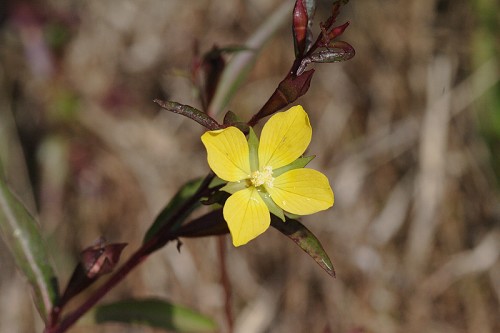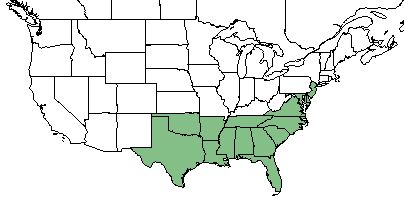Difference between revisions of "Ludwigia linearis"
HaleighJoM (talk | contribs) (→Ecology) |
|||
| (10 intermediate revisions by 6 users not shown) | |||
| Line 1: | Line 1: | ||
{{italic title}} | {{italic title}} | ||
| − | Common name: narrowleaf primrose-willow <ref name= "USDA Plant Database"/>, eastern narrowleaf seedbox <ref name= "Weakley 2015"/> | + | Common name: narrowleaf primrose-willow<ref name= "USDA Plant Database"/>, eastern narrowleaf seedbox<ref name= "Weakley 2015"/> |
<!-- Get the taxonomy information from the NRCS Plants database --> | <!-- Get the taxonomy information from the NRCS Plants database --> | ||
{{taxobox | {{taxobox | ||
| Line 19: | Line 19: | ||
}} | }} | ||
==Taxonomic Notes== | ==Taxonomic Notes== | ||
| − | Synonyms: none | + | Synonyms: none.<ref name="weakley">Weakley, A.S. 2015. Flora of the southern and mid-atlantic states. Working Draft of 21 May 2015. University of North Carolina at Chapel Hill, Chapel Hill, North Carolina.</ref> |
| − | Varieties: ''Ludwigia linearis'' Walter var. ''puberula'' Engelmann & A. Gray | + | Varieties: ''Ludwigia linearis'' Walter ''var. linearis'', ''Ludwigia linearis'' Walter var. ''puberula'' Engelmann & A. Gray.<ref name="weakley">Weakley, A.S. 2015. Flora of the southern and mid-atlantic states. Working Draft of 21 May 2015. University of North Carolina at Chapel Hill, Chapel Hill, North Carolina.</ref> |
==Description== | ==Description== | ||
<!-- Basic life history facts such as annual/perrenial, monoecious/dioecious, root morphology, seed type, etc. --> | <!-- Basic life history facts such as annual/perrenial, monoecious/dioecious, root morphology, seed type, etc. --> | ||
| − | ''L. linearis'' is a perennial forb/herb of the ''Onagraceae'' family native to North America. <ref name= "USDA Plant Database"> USDA Plant Database [https://plants.usda.gov/core/profile?symbol=LULI https://plants.usda.gov/core/profile?symbol=LULI] </ref> | + | ''L. linearis'' is a perennial forb/herb of the ''Onagraceae'' family native to North America.<ref name= "USDA Plant Database"> USDA Plant Database [https://plants.usda.gov/core/profile?symbol=LULI https://plants.usda.gov/core/profile?symbol=LULI] </ref> |
==Distribution== | ==Distribution== | ||
| − | ''L. linearis'' | + | ''L. linearis var. linearis'' ranges from southern New Jersey to central peninsular Florida, west to southeastern Louisiana, and inland to the Cumberland Plateau of northcentral Alabama and central Tennessee.<ref name="weakley">Weakley, A.S. 2015. Flora of the southern and mid-atlantic states. Working Draft of 21 May 2015. University of North Carolina at Chapel Hill, Chapel Hill, North Carolina.</ref> ''L. linearis var. puberula'' ranges from central Alabama to central Arizona and eastern Missouri, south to eastern Texas, and north to Florida and North Carolina.<ref name="weakley">Weakley, A.S. 2015. Flora of the southern and mid-atlantic states. Working Draft of 21 May 2015. University of North Carolina at Chapel Hill, Chapel Hill, North Carolina.</ref> |
==Ecology== | ==Ecology== | ||
===Habitat=== <!--Natural communities, human disturbed habitats, topography, hydrology, soils, light, fire regime requirements for removal of competition, etc.--> | ===Habitat=== <!--Natural communities, human disturbed habitats, topography, hydrology, soils, light, fire regime requirements for removal of competition, etc.--> | ||
| − | ''L. linearis'' proliferates in savannas and interdunal swales. <ref name= "Weakley 2015"> Weakley, A. S. (2015). Flora of the Southern and Mid-Atlantic States. Chapel Hill, NC, University of North Carolina Herbarium. </ref> | + | ''L. linearis'' proliferates in savannas and interdunal swales.<ref name= "Weakley 2015"> Weakley, A. S. (2015). Flora of the Southern and Mid-Atlantic States. Chapel Hill, NC, University of North Carolina Herbarium. </ref> Specimens have been collected from shallow water of pond, longleaf pine flatwoods, moist sandy loam of roadside, cypress swamp, black sandy peat, wiregrass wet pine flatwoods, wet savanna, and sandy clay of cleared loblolly pine flat.<ref name = "FSU herbarium"> URL: http://herbarium.bio.fsu.edu. Last accessed: June 2018. Collectors: Loran C. Anderson, Nancy E. Jordan, Cecil Slaughter, Marc Minno, Ann F. Johnson, Neal Morar, R.K. Godfrey, O. Lakela, R. Kral, Sidney McDaniel, Richard Houk, Bruce Hansen, JoAnn Hansen, A.H. Curtiss, R. Komarek, Annie Schmidt. States and counties: Florida (Nassau, Liberty, Franklin, Clay, Escambia, Washington, Wakulla, Dixie, Hillsborough, Taylor, Leon, Jefferson, Hamilton, Gulf, Calhoun, Santa Rosa, Okaloosa, Walton, Jackson, Gadsden, Calhoun, Bay) Georgia (Seminole, Thomas, Atkinson) Alabama (Mobile) Texas (Orange) Arkansas (Calhoun)</ref> |
| + | |||
| + | ''Ludwigia linearis'' is an indicator species for the Peninsula Savannas community type as described in Carr et al. (2010).<ref>Carr, S.C., K.M. Robertson, and R.K. Peet. 2010. A vegetation classification of fire-dependent pinelands of Florida. Castanea 75:153-189.</ref> | ||
| + | |||
===Phenology=== <!--Timing off flowering, fruiting, seed dispersal, and environmental triggers. Cite PanFlora website if appropriate: http://www.gilnelson.com/PanFlora/ --> | ===Phenology=== <!--Timing off flowering, fruiting, seed dispersal, and environmental triggers. Cite PanFlora website if appropriate: http://www.gilnelson.com/PanFlora/ --> | ||
| − | ''L. linearis'' flowers | + | ''L. linearis'' flowers from June to September.<ref name="weakley">Weakley, A.S. 2015. Flora of the southern and mid-atlantic states. Working Draft of 21 May 2015. University of North Carolina at Chapel Hill, Chapel Hill, North Carolina.</ref> |
<!--===Seed dispersal===--> | <!--===Seed dispersal===--> | ||
<!--===Seed bank and germination===--> | <!--===Seed bank and germination===--> | ||
<!--===Fire ecology===--> <!--Fire tolerance, fire dependence, adaptive fire responses--> | <!--===Fire ecology===--> <!--Fire tolerance, fire dependence, adaptive fire responses--> | ||
<!--===Pollination===--> | <!--===Pollination===--> | ||
| − | <!--=== | + | <!--===Herbivory and toxicology===--> |
| − | <!--==Diseases and parasites==--> | + | <!--===Diseases and parasites===--> |
| − | ==Conservation and | + | ==Conservation, cultivation, and restoration== |
| − | == | + | ==Cultural use== |
==Photo Gallery== | ==Photo Gallery== | ||
<gallery widths=180px> | <gallery widths=180px> | ||
</gallery> | </gallery> | ||
==References and notes== | ==References and notes== | ||
Latest revision as of 14:47, 14 July 2022
Common name: narrowleaf primrose-willow[1], eastern narrowleaf seedbox[2]
| Ludwigia linearis | |
|---|---|

| |
| Photo by the Southeastern Flora Database | |
| Scientific classification | |
| Kingdom: | Plantae |
| Division: | Magnoliophyta - Flowering plants |
| Class: | Magnoliopsida - Dicots |
| Order: | Myrtales |
| Family: | Onagraceae |
| Genus: | Ludwigia |
| Species: | L. linearis |
| Binomial name | |
| Ludwigia linearis Walter | |

| |
| Natural range of Ludwigia linearis from USDA NRCS Plants Database. | |
Contents
Taxonomic Notes
Synonyms: none.[3]
Varieties: Ludwigia linearis Walter var. linearis, Ludwigia linearis Walter var. puberula Engelmann & A. Gray.[3]
Description
L. linearis is a perennial forb/herb of the Onagraceae family native to North America.[1]
Distribution
L. linearis var. linearis ranges from southern New Jersey to central peninsular Florida, west to southeastern Louisiana, and inland to the Cumberland Plateau of northcentral Alabama and central Tennessee.[3] L. linearis var. puberula ranges from central Alabama to central Arizona and eastern Missouri, south to eastern Texas, and north to Florida and North Carolina.[3]
Ecology
Habitat
L. linearis proliferates in savannas and interdunal swales.[2] Specimens have been collected from shallow water of pond, longleaf pine flatwoods, moist sandy loam of roadside, cypress swamp, black sandy peat, wiregrass wet pine flatwoods, wet savanna, and sandy clay of cleared loblolly pine flat.[4]
Ludwigia linearis is an indicator species for the Peninsula Savannas community type as described in Carr et al. (2010).[5]
Phenology
L. linearis flowers from June to September.[3]
Conservation, cultivation, and restoration
Cultural use
Photo Gallery
References and notes
- ↑ 1.0 1.1 USDA Plant Database https://plants.usda.gov/core/profile?symbol=LULI
- ↑ 2.0 2.1 Weakley, A. S. (2015). Flora of the Southern and Mid-Atlantic States. Chapel Hill, NC, University of North Carolina Herbarium.
- ↑ 3.0 3.1 3.2 3.3 3.4 Weakley, A.S. 2015. Flora of the southern and mid-atlantic states. Working Draft of 21 May 2015. University of North Carolina at Chapel Hill, Chapel Hill, North Carolina.
- ↑ URL: http://herbarium.bio.fsu.edu. Last accessed: June 2018. Collectors: Loran C. Anderson, Nancy E. Jordan, Cecil Slaughter, Marc Minno, Ann F. Johnson, Neal Morar, R.K. Godfrey, O. Lakela, R. Kral, Sidney McDaniel, Richard Houk, Bruce Hansen, JoAnn Hansen, A.H. Curtiss, R. Komarek, Annie Schmidt. States and counties: Florida (Nassau, Liberty, Franklin, Clay, Escambia, Washington, Wakulla, Dixie, Hillsborough, Taylor, Leon, Jefferson, Hamilton, Gulf, Calhoun, Santa Rosa, Okaloosa, Walton, Jackson, Gadsden, Calhoun, Bay) Georgia (Seminole, Thomas, Atkinson) Alabama (Mobile) Texas (Orange) Arkansas (Calhoun)
- ↑ Carr, S.C., K.M. Robertson, and R.K. Peet. 2010. A vegetation classification of fire-dependent pinelands of Florida. Castanea 75:153-189.